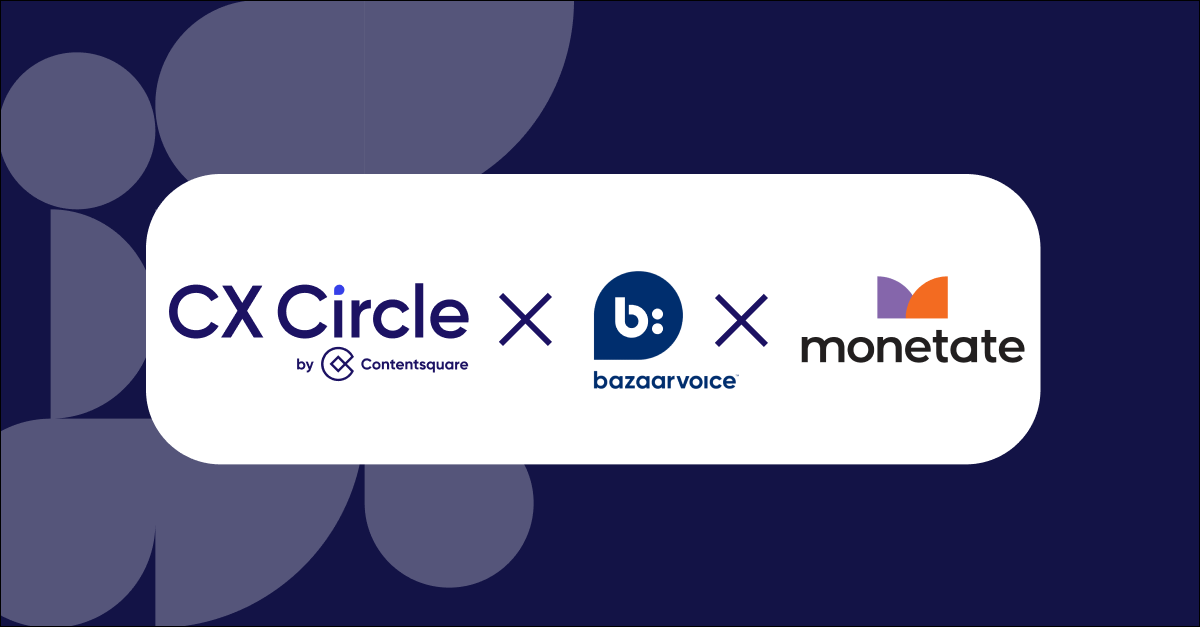
Digital Experience in the New Era: A Q&A with Bazaarvoice and Monetate

- Q: The user journey is getting more complex and complicated as users shop on multiple devices and channels. How can brands keep up and still offer intentional and personalized experiences?
- Q: How are you users behaving differently now vs five years ago? What’s driving this? How do you see this continuing to evolve?
- Q: As the peak retail shopping season nears, what’s one piece of advice you can share?
- Q: How do you view personalization as a tier of CX? How will AI affect personalization in the future?
- Bonus Q: How do you see user-generated content (UGC) evolving in the next 5 years? (AR/VR, etc.?)
- Bonus Q: If you could only share one best practice for experimentation, what would it be?
- Monetate, Bazaarvoice and more at CX Circle 2023
Contentsquare’s annual global event, CX Circle, is just around the corner. This year’s event, hosted on September 28, is focused on the new era of digital experience. So we sat down with our technology partners speaking at the event, Bazaarvoice and Monetate, to get their thoughts, advice and predictions for the evolution of digital experience.
Emma Madison, SVP of Client Success at Bazaarvoice and Andrew Koperwas, CMO of Monetate, answer some of our most pressing CX-driven questions below.
See the full lineup of industry experts and leading brands at CX Circle and register to attend virtually today.
Q: The user journey is getting more complex and complicated as users shop on multiple devices and channels. How can brands keep up and still offer intentional and personalized experiences?
Emma Madison: When thinking about an omnichannel strategy, it is important not to leave any gaps in your shopper’s journey. We now have to look at leveraging new forms of UGC (including visual and social, expert content, pro content, etc.), pushing these forms of content up and down the engagement funnel (UGC doesn’t only belong on your website; it also belongs on your social channels, emails, ads, marketplaces and in-store), and you have to do all this while still optimizing this content on site and using data to improve along the way. Social commerce is a great example of omnichannel commerce at work. It combines the engaging and inspirational elements of social media content with the conversion-oriented components of a product page. Social commerce essentially makes your social media content shoppable. It shows social proof with customer photos and entertains your audience with videos or interactive quizzes and polls while tagging them with products. Shoppers can click on the tagged products to learn more on your website or make a purchase directly in the app.
Andrew Koperwas: To keep up with customer expectations and complicated customer journeys, brands need to focus on the following:
- Internal Team Dynamics: For example, at a retail brand, an eCommerce merchandiser might own the product detail page with a set of goals, there might be a team in charge of the mobile app experience that has different KPIs, there might be a testing and experimentation lead that has a completely disconnected plan as well.
Companies that excel at this are designing an intentional, holistic strategy. It sounds like common sense, but aligning teams on a strategy is challenging. To simplify it, sometimes a brand team might be more concerned with the overall customer experience, whereas the eCommerce team might be concerned with driving conversion. Having shared goals, a shared strategy, and a roadmap driven by tests and insights can make personalization a reality.
- Data and Profile Information: Privacy concerns have caused the technical landscape to shift and make it more difficult to identify and understand users. Zero cookies, consolidated data profiles across devices and the ability to use contextual, real-time data can impact your ability to deliver a personalized experience.
Plenty of technologies enable an easier look into real-time contextual and behavioral data to inform better customer experiences. It’s also important to realize that perfect is never going to happen. Leveraging native integrations between software makes it easy to get quick insights to design and launch experiences you can test and iterate on.
- Understand Your Users: Some brands must offer different experiences or bring on new channels because they are the topic du jour. It’s important to step back and think about Marketing 101—What do my customers care about, and how can I connect my brand better to that?
Test, test, and test some more! The benefit of better customer insights means that you can test and launch new experiences constantly. Leveraging the data better informs what you know about your customers and how they will interact with your channels so you can continue providing the experience they seek. Not necessarily the “best” customer experience, but what is best for your customers.
Q: How are you users behaving differently now vs five years ago? What’s driving this? How do you see this continuing to evolve?
EM: Customers expect a brand to know them and are much more vocal about holding brands accountable to transparency, authenticity and trust. In our industry, we see a growing desire to hear from fellow consumers rather than solely relying on brand messages. This gives brands an incredibly powerful opportunity to integrate customers into their brand identity and transform them into enthusiastic advocates.
Q: As the peak retail shopping season nears, what’s one piece of advice you can share?
EM: Audit product pages now and see where the gaps are for UGC. As you can imagine, reviews play a key role in shoppers’ decision-making and purchasing habits. In fact, best-in-class sites with UGC see a 190% revenue per visitor lift and a 145% higher conversion rate. With holiday products having a shorter shelf life, you need high conversions to get your products flying this holiday season.
AK: My advice would be to leverage the power of scarcity. Relying on proven sociological theories, such as scarcity messaging or social proofing, is a proven way to drive sales in a short time. Leveraging features such as social proof (e.g., 1,000 people have bought this item in the last 24 hours ) as a part of the holiday period is a key tactic our client base is using in 2023.
Q: How do you view personalization as a tier of CX? How will AI affect personalization in the future?
EM: I view this in two ways: Using AI to power experiences should make the shopping journey more efficient and enjoyable for customers to find what they like and convert and relate to consumer peers and their experiences. On the other hand, Bazaarvoice is very focused on how Generative AI will influence and impact content creation and the trust consumers have in the content they’re viewing, so we see this as a moment where a focus on authenticity becomes more imperative than ever. We have to address generative AI with diligence around authenticity.
AK: AI continues to make true personalization a reality. Monetate launched one of the first AI/ML-powered personalization engines in 2016 that delivered one-to-one experiences! Continued client usage and millions of more data points have refined the model to learn better how to have more personalized experiences. One of the issues has always been the content bottleneck, though. While we may have the right data and way to deliver experiences, brands are restricted as we don’t want to create bespoke images or copy for each person.
However, the recent jump in generative AI helps visualize where this can become a reality. While still in the early stages, clients have played around with ChatGPT and other generative AI engines to create better content. While it’s not quite ready to scale up, organizations must consider how this will integrate into their content creation roadmap.
Bonus Q: How do you see user-generated content (UGC) evolving in the next 5 years? (AR/VR, etc.?)
EM: We have been on a journey where we have seen the preference for content from consumers shift. Consumers have been developing a preference for the type of content they see (and often click through on) on social media platforms. With the rise of video as a preferred type of content, we’re veering increasingly into the space of immersive experiences. We have already seen many customers start to embrace the concept of virtual shopping. This will only increase as more consumer technology emerges that makes it accessible and demand for such an experience rises.
Bonus Q: If you could only share one best practice for experimentation, what would it be?
AK: Science works! Create a hypothesis of what you want to change. We often see clients base their testing strategy on what content is available to them at the moment—the path of least resistance. The issue then becomes that a test reaches significance, but there is no clear next action. I always prefer quality over quantity. Don’t test for the sake of testing, but have a clear hypothesis in mind and design the experiment around it to avoid wasting time and resources.
Monetate, Bazaarvoice and more at CX Circle 2023
As expectations and innovations in the digital landscape expand, the importance of digital customer experience will continue rising. Businesses prioritizing exceptional digital experiences and investing in technologies (like Monetate and Bazaarvoice) to understand, analyze and test their customers’ digital experiences will delight, convert and retain more customers.
Want more inspiration and advice for improving your brand’s digital experiences? Hear from industry experts and leading brands on leveraging data and AI, implementing customer-centric best practices, adopting new technologies and more at this year’s CX Circle.
For those confirmed to attend in person, join the breakfast round table with Bazaarvoice and Monetate at 10:15AM ET.
For everyone else, register now to secure your spot for the virtual event on September 28.




